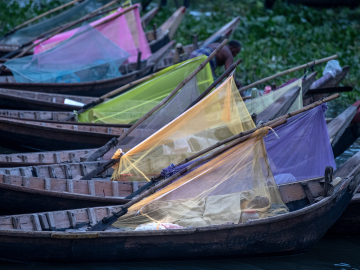More Than a Medical Story: A Q&A with Hannah McNeish
Before Hannah McNeish began her research on hemophilia care in Kenya, she expected to write a medical story. Factor concentrates—the medications used to treat the blood disorder—were an important part of the story, but she found much more.
She found that fewer than 1/10th of the 5,000 Kenyans believed to be living with hemophilia have been diagnosed and registered—and still fewer are getting the treatment they need. She learned about the terrible pain that many endure because of lack of access to factor. (There are only 4 hemophilia care clinics in the country of 50 million people.) She also learned that even when factor is available, its cost far outstrips most Kenyan’s capacity to pay for it.
McNeish says she also found remarkable people persevering through horrific challenges and rising up to lead improvements in hemophilia care in their country.
In this Q&A, McNeish shares the backstory to her reporting for the series, “'We Are Many': The Race to Treat Hemophilia in Kenya.”
Did you have any experience with hemophilia before beginning the project?
Absolutely no. When I looked into the stats, it was like, "Oh, this affects more people than I thought and this isn't a condition of the past." I wasn't really prepared for discovering that in Kenya and other places, that if you have this condition, that your options are so limited and that medicine is just not there, even at the largest hospitals.
Even when I covered sleeping sickness deep in the Congolese jungle and when I was covering leishmaniasis and all these really obscure diseases, it seemed like there were easier cures, or more medicine.
What’s really stayed with you from your reporting?
I think what struck [photographer Will Swanson] and I the most was just how everybody we spoke to was so nice and so patient, and almost casually dropped into conversation that they've nearly died, or they've been in a coma, or they've had to spend hundreds of dollars to even get to the hospital. And they were accepting of this, and we were so shocked because it just seemed like such an unfair condition.
The condition really has a terrible impact on women and families.
I spoke to all these women who had abuse hurled at them by the people that they held dearest when they found out that this was a condition carried by women—it was really heartbreaking. And then to see and hear about the devastation that these family breakups cause.
I was at Maureen Miruka's house and her son Ethan was playing in the carpark, and she was telling me about losing a 5-year-old in such traumatic circumstances and watching him just waste away and wither. And then hearing that she had lost a baby … and then realizing that she not only lost 1 but 2 sons to hemophilia. And we were hearing her third son, Ethan, who has severe hemophilia, playing outside. And she said to me, "Look, if we hear him scream or even anything a yelp, this entire house races outside. Everybody is on alert."
I heard from her and other mothers of just what it's like to live with this, in constant fear. Maureen said it's like sitting at the edge of your seat constantly. And even as I was sitting there, I found that I was also sitting on the edge of my seat as you heard these kids playing outside, because a bump or cut for someone who has severe hemophilia means they keep bleeding internally or externally until treatment comes and can be crippling or fatal if not dealt with quickly.
You documented how expensive and scare the factor concentrates are. Were any of your sources optimistic that access would improve and prices would come down eventually?
People in Kenya are so far away from the process of the pharmaceuticals because it's all made in Europe and the US, that I didn't get that hope that the price of drugs would come down. What people really hoped for was that the government would get more involved and buy these drugs. Because as Glenn Pierce from the World Federation of Hemophilia just kind of said, the price would have to come down so much to make a difference in places like Kenya that it's just not possible.
I think people were just hoping that the government could really help in subsidizing this, making sure it's more accessible. Kenya's one of the places that's actually made progress because it has these hemophilia patient-led organizations so organizations like WFH can donate through them. In other countries, there's absolutely nothing.
In your third story, Jane Mugasha, who coordinates hemophilia services in the Mount Kenya region, came across as really amazing. What was she like in person?
She was just so matter of fact. I said, "How did you get into this?" And she was just curious, and she cared so much about her patients and the fact that she almost lost this boy that came in for a circumcision. She and her staff just kept dressing the wound and couldn't stop him from bleeding, and kept transfusing, and then eventually sent him off in an ambulance. And instead of getting on with other cases, it really piqued her interest, and she just thought, "No, I want to know what happened to him. I want to make sure that I can help these people."
She had to go back to the books for the first time in years and read about hemophilia. And it was great to find the solution that you gave people clotting factor concentrates, but then there was no use because she didn't have them in her hospital.
What really struck me about Jane, as well as Maureen, is that they were just 2 very strong individuals who had the determination, and the passion to just fight for not themselves, but for other people. Because Maureen, she had lost 2 sons, and she just said, "I never want another mother to go through this. I never want someone to suffer the loneliness, and the confusion, and the pain that I did." And Jane Mugasha was the same. She just said, "I want to know how to make this better." And when she learned about it, she started seeing more and more people in the area of Muranga, she said, "I just want to stop people being crippled in their childhood."
And it was amazing hearing the story of how these 2 women came together, and then form 1 small organization. And all of a sudden, there was this one woman who was not only training everybody in her hospital … but everybody that she could find all over northern Kenya, trying to come up with solutions. Just the determination and the will, and the compassion of those 2 women was quite astounding.
Did anything else stand out to you?
I came into this story thinking about it as a purely medical story, but it wasn't just about the medicine, having the medicine in a lot of places. It was about having a community of people. Maureen said to me, "I didn't just set up this Jose Memorial Haemophilia Society to get medicine. It was to have a community. It was to have a WhatsApp group so that we could all share information, because there's just nothing out there--when the doctor's don't even know. And give each other emotional support as well."
Read the whole GHN series “‘We are Many’: The Race to Treat Hemophilia in Kenya” here.
Join the tens of thousands of subscribers who rely on Global Health NOW summaries and exclusive articles for the latest public health news. Sign up for our free weekday enewsletter, and please share the link with friends and colleagues: http://www.globalhealthnow.org/subscribe.html
Journalist Hannah McNeish documented hemophilia's devastation and hope in Kenya. Image: Courtesy





